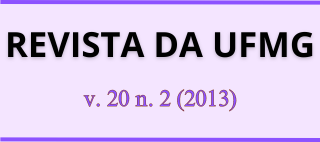No princípio era a água
DOI:
https://doi.org/10.35699/2316-770X.2013.2689Palabras clave:
Cosmogonias babilônicas, Cosmogonias hebraicas, Cosmogonias gregasResumen
Este trabalho trata das cosmogonias babilônicas que instituem a água como o princípio de tudo, bem como das tradições grega e hebraica delas dependentes. No poema intitulado Enuma elish, escrito provavelmente no século XII a.C., Apsû e Tiamat – a água das fontes e a água do mar, respectivamente – são apresentados como os primeiros deuses, a partir dos quais o mundo ganha forma. Ressalta-se como, provindo de povos que vivem no deserto, esses mitos sublinham o caráter da água como fonte de vida, ao mesmo tempo que elaboram uma imagem do mar como uma força perigosa que é preciso conter em seus limites, tarefa que cabe ao mais jovem dos deuses, responsável pela ordem do mundo.
Descargas
Citas
A BÍBLIA de Jerusalém. São Paulo: Paulinas, 1985.AGUSTÍN, S. Las confesiones. Edición crítica e anotada por Angel Custodio Vega. Madrid: Biblioteca de Autores Cristianos, 1974.
ARISTÓTELES. Metaf ísica. Edición trilingüe por Valentín García Yebra. Madrid: Gredos, 1982.
BOTTÉRO, J. Nascimento de Deus: a Bíblia e o historiador. Tradução de Rosa Freire D’Aguiar. São Paulo: Paz e Terra, 1993.
BOTTÉRO, J.; KRAMER, S. N. Lorsque les dieux faisaient l’homme: mythologie mésopotamienne. Paris: Gallimard, 1993.
CONNERY, C. There was no More Sea: the Supersession of the Ocean, from the Bible to Cyperspace. Journal of historical geography, v. 32, p. 494-511, 2006.
D’AGOSTINO, F. Gilgamesh o la conquista de la inmortalidad. Traducción de Francisco del Río Sánchez. Madrid: Trotta, 2007.
DAMASCIUS. Traité des premiers principes. Texte établi par Leendert Gerrit Westerink et traduit par Joseph Combès. Paris: Les Belles Lettres, 1991. v. 3.
ENUMA Elish: The Babylonian Epic of Creation. The Cuneiform Text by Wilfred G. Lambert and S. B. Parker. Oxford: Clarendon, 1966.
HÉSIODE. Théogonie, les travaux et les jours, le bouclier. Texte établi et traduit par Paul Mazon. Paris: Les Belles Lettres, 1982.
HESÍODO. Teogonia: a origem dos deuses. Estudo e tradução de Jaa Torrano. São Paulo: Iluminuras, 1991.
HOMER. The Iliad. Edited with an Introduction and Commentary by M. M. Willcock. London: St Martin’s Press, 1984.58. Para detalhamento de outros aspectos das informações transmitidas por Damáscio, ver TALON, 2001, p. 271-274.
KEE, M. S. A Study on the Dual Form of Mayim, Water. Jewish Bible Quartely, v. 40, n. 3, p. 183-189, 2012.
KELLY, A. ΑΨΟΡΡΟΟϒ ΩΚΕΑΝΟΙΟ: a babylonian reminiscence? The Classical Quartely, v. 57, n. 1, p. 280-282, 2007.
LABAT, R. et al. Les religions de Proche-Orient asiatique: textes babyloniens, ougaritiques, hittites. Paris: Fayard/Denoël, 1970.
LAMBERT, W. G. Berossus and Babylonian Eschatology. Iraq, v. 38, n. 2, p. 171-173, 1976.LAMBERT, W. G. Mesopotamian Creation Stories. In: GELLER, M. J.; SCHIPPER, M. (Ed.). Imagining creation. Leiden: Brill, 2008.
NOVUM Testamentum Graece. Ed. Barbara Aland, Kurt Aland, Joahannes Karavidopoulos, Carlo M. Martini, Bruce M. Metzger. 27. ed. Stuttgart: Deutsche Bibelgesellschaft, 1995.
PÉLICIER, Y. A origem. In: BRENOT, P. (Ed.). As origens. Tradução de José Carlos Almeida. Lisboa: Presença, 1991. p. 17-35.
PHILO OF ALEXANDRIA. On the Creation of the Cosmos According to Moses. Translation and commentary by David T. Runia. Leiden: Brill, 2001.
PHILON D’ALEXANDRIE. De opificio mundi. Introduction, traduction et notes par R. Arnaldez. Paris: Du Cerf, 1961.
SEPTUAGINTA id est Vestus Testamentum graece iuxta LXX interpretes. Ed. Alfred Rahlfs. 9. ed. Stuttgart: Deutsche Bibelstiftung, 1935.
SERI, A. The Fifty Names of Marduk on Enuma Elish. The Journal of the American Oriental Society, v. 126, n. 1, p. 507-519, 2006.
SERI, A. The Role of Creation in Enuma Elish. Journal of Ancient Near Eastern Religions, v. 12, p. 4-29, 2012.
SONIK, K. Bad King, False King, True King: Apsû and his Heirs. Journal of the American Oriental Society, v. 128, n. 4, p. 737-743, 2008.
SYLVA, D. The rising תורהנ of Psalm 93: Chaotic Order. Journal for the Study of the Old Testament, v. 36, n. 4, p. 471-482, 2012.
SYNCELLUS, G. Ecloga chronographica. Ed. A. A. Mosshammer. Leipzig: Teubner, 1984.
TALON, P. Enuma Elish and the Transmission of Babylonian Cosmology to the West. In: WHITING, R. M. (Ed.). Mythology and Mythologies: Methodological Approaches to Intercultural Influences (Procedings of the Second Annual Symposium of the Assyrian and Babylonian Intellectual Heritage Project). Helsinki: University of Helsinki Neo-Assyrian Text Corpus Project, 2001. p. 265-277.
THE STANDARD Babylonian Creation Myth Enuma Elish: Introduction, Cuneiform Text, Transliteration, and Sign List with a Translation and Glossary in French by Philippe Talon. Helsinki: University of Helsinki Neo-Assyrian Text Corpus Project, 2005.
TORAH Nevi’im vKtuvim. Israel: The United Bible Society, 1978.
TUGENDHAFT, A. Unsettling Sovereignty: Politics and Poetics in the Baal Cycle. Journal of the American Oriental Society, v. 132, n. 3, p. 367-384, 2012.
VAZ, A. S. A visão das origens em Génesis 2, 4b-3, 24: coerência temática e unidade literária. Lisboa: Edições Didaskalia, 1996.
WALCOT, P. Hesiod and the Near East. Cardiff: Wales University Press, 1966.
WEST, M. L. The East face of Helicon: West Asiatic Elements in Greek Poetry and Myth. Oxford: Clarendon, 1997.
WESTENHOLZ, J. G. In the Shadow of the Muses: a View of Akkadian Literature. The Journal of the American Oriental Society, v. 119, n. 1, p. 80-87, 1999.
YITZJAKI, S. El Pentateuco con el comentario de Rabí Shlomo Yitzjaki (Rashi). Traducción por Enrique Jaime Zadoff e Jaime Barilko. Buenos Aires: Yehuda, [s./d.].




